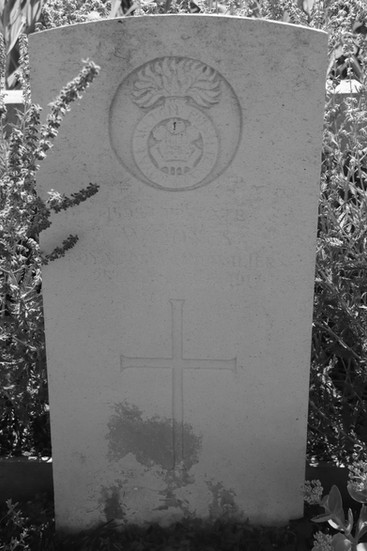Locre Hospice Cemetery
- Admin
- Sep 28, 2024
- 4 min read
Updated: 1 day ago

Locre (now Loker) was in Allied hands during the greater part of the war, and field ambulances were stationed in the Convent of St. Antoine. The village changed hands several times between 25 and 30 April 1918, when it was recaptured by the French. The hospice, or convent, was the scene of severe fighting on 20 May, but was not retaken until first week in July. The Hospice Cemetery was begun in June 1917 by field ambulances and fighting units, and was used until April 1918. After the Armistice four graves were transferred to it from the garden of the Hospice, which was ultimately rebuilt and dominates the area.

Major William Hoey Kearney (Willie) Redmond M.P.
A Celtic cross, marking the grave of Major W H K (Willie) Redmond, Member of Parliament for Wexford, stands 100 meters along a grass track on the northern side of the cemetery. Major Redmond was mortally wounded at the Battle of Messines and was buried in the Convent Garden of the Locre Hospice, and his widow erected this memorial to mark his grave. Until the late 1950's the grave was maintained by a Sister from the (new) Locre hospice. In the 1990's the land was purchased by the Belgian State and is now maintained by the Commonwealth War Graves Commission.
Two Senior British Officers
Brigadier General R.C. MacLachlan DSO, commanding 112th Brigade, 37th Division, was killed by a sniper at 7am on 11 August 1917, while going round the line with his GSO 1 Lieutenant Colonel Gill. He is buried in Plot II, Grave C.9. Beside him is Lieutenant Colonel Richard Chester Chester-Master DSO and Bar. He commanded the 13th Battalion, King’s Royal Rifle Corps. He had been in command of the battalion since March 1915 and had served on the Somme, Arras, and at Ypres. He was killed by a sniper on 30 August 1917. He was a professional soldier who had served in the Boer War and was Chief Constable of Gloucestershire and on the reserve list when war was declared. His epitaph comes from the Remembrance hymn O Valiant Hearts which was written by Sir John Arkwright in 1917. Richard's wife, Geraldine, was the sister of Arkwright and it was she who chose the inscription.

Shot at Dawn
There are two men buried here who were shot at dawn.
40435 Private Denis Jetson Blakemore, Age 28, Grave I.A.22. Son of George L. and Sophia Blakemore, of 3, St. George's Street, Mountfields, Shrewsbury. Native of Bicton, Shrewsbury. 8th North Staffordshires, 57th Brigade, 19th (Western) Division. He deserted near Wytschaete on 6 June 1917. This was his second offence; he had already been sentenced to death, but this had been suspended. He was arrested at Boulogne whilst pretending to be a member of the Army Service Corps. He was shot at Locre on 9 July 1917.
Epitaph – Thy will be done
15954 Private William Jones, Grave I.C.4. 9th Royal Welsh Fusiliers, 58th Brigade, 19th Division. He had been serving as a stretcher bearer since July 1915. His commanding officer said he was of good character and Putkowski & Sykes in their research state that according to army records he was under a suspended sentence of death for desertion. He was the last deserter to escape across the channel to the UK. He absconded on 15 June 1917 while taking a wounded man to a dressing station. He surrendered to the assistant provost - marshal in Bristol on 4 September telling him that he had been wounded before being sent back to England. He was shot on Kemmel Hill on 25 October 1917.
The cemetery was designed by W H Cowlishaw.
Cemetery Location
Locre Hospice Cemetery is located 10.5 Kms south-west of Ieper town centre on the Godtschalckstraat, a road leading from the Dikkebusseweg (N375). From Ieper town centre the Dikkebusseweg is reached via Elverdingsestraat, straight over a roundabout onto Capronstraat (for 30 metres), then left along M. Fochlaan. Immediately after the train station, the first right hand turning is the Dikkebusseweg. On reaching the village of Loker (formerly Locre) the first left hand turning leads onto the Kemmelbergweg. There follows an immediate right hand turning onto Godtschalckstraat. The cemetery is located 900 metres along the Godtschalckstraat on the right-hand side of the road. A small 20 metre grassed access path leads to this site.
Burials
The cemetery now contains 243 Commonwealth burials and commemorations of the First World War. Twelve of the burials are unidentified and ten graves destroyed by shellfire are now represented by Special Memorials.
The 14 Second World War burials date from late May 1940 and the withdrawal of the British Expeditionary Force to Dunkirk ahead of the German advance.
There are also two German burials from the First World War in the cemetery.
UK – 238
Australian – 2
New Zealand – 1
Canadian – 1
British West Indies – 1
German – 2
Special Memorials to ten men whose graves were destroyed by shellfire.





Comments